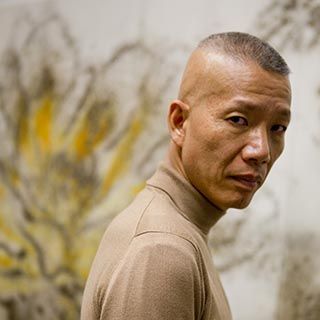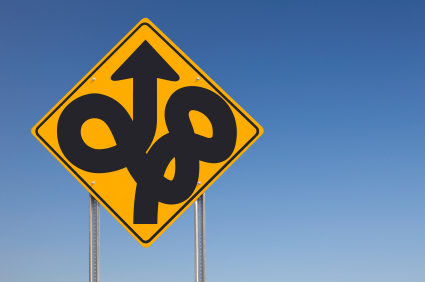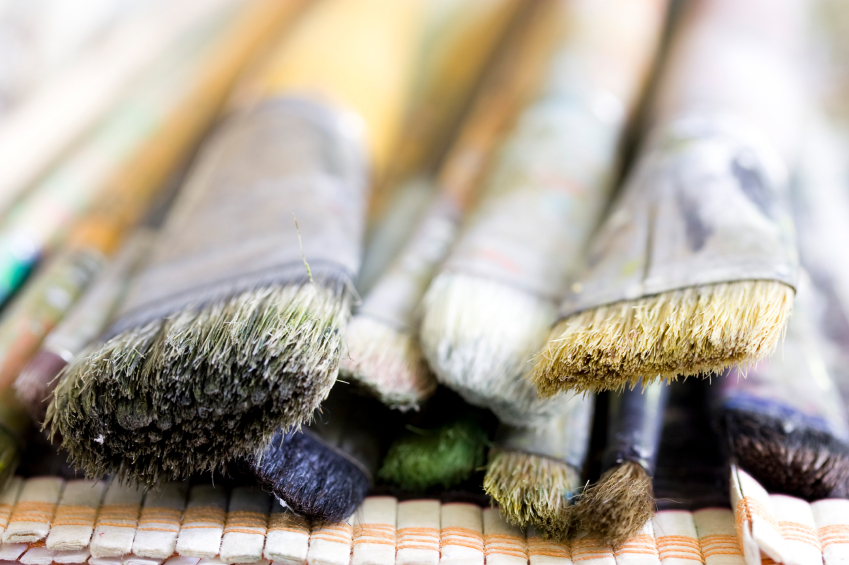Wednesday 30th July 2014Artist Spotlight: Cai Guo-Qiang Most of us in the art world have heard of Ai Weiwei, a famous Chinese artist slash dissident who's been making headlines with his challenges to the dictatorially smothering cultural atmosphere in the world's most populous nation. But perhaps fewer have heard of Cai Guo-Qiang, however unfairly, since he's equally controversial and has a remarkably distinguished artistic career. Born in Quanzhou, Fujian Province, China in 1957, he has been living and working in New York City since the mid 1980s, and has a decided penchant for grandiose works of epic scale.
Most of us in the art world have heard of Ai Weiwei, a famous Chinese artist slash dissident who's been making headlines with his challenges to the dictatorially smothering cultural atmosphere in the world's most populous nation. But perhaps fewer have heard of Cai Guo-Qiang, however unfairly, since he's equally controversial and has a remarkably distinguished artistic career. Born in Quanzhou, Fujian Province, China in 1957, he has been living and working in New York City since the mid 1980s, and has a decided penchant for grandiose works of epic scale.
Cai has had quite a distinguished career, earning numerous plaudits and awards from various juried competitions, and worked as the Director of Visual and Special Effects at the 2008 Olympic Games in Beijing, a fitting assignment for an artist whose grand scale of work is matched only by his impressive visual flair.
Monday 28th July 2014Public Art Thefts Public art is often something a gamble. When bureaucracy and art intertwine, it's not always with pleasing results. A perfect example occurred in Ottawa, Canada, recently this year when a public art installation was erected whose entire design and premise was based on an incorrect encyclopedia entry, leading to snickers and jeers and red-faced officials. Almost the opposite occurred recently in New York City, when the Department of Transportation put up a sign-based art project throughout the city.
Public art is often something a gamble. When bureaucracy and art intertwine, it's not always with pleasing results. A perfect example occurred in Ottawa, Canada, recently this year when a public art installation was erected whose entire design and premise was based on an incorrect encyclopedia entry, leading to snickers and jeers and red-faced officials. Almost the opposite occurred recently in New York City, when the Department of Transportation put up a sign-based art project throughout the city.
It raises a question about street art that has also been raised thanks to the incredible values placed on works by popular street artist Banksy about who actually owns the pieces that are created on walls and other "canvases" that aren't actually owned by the artist. In this particular case, of course, it's likely that the Department of Transportation could be considered the actual owners of the pieces, but street signage is stolen fairly frequently, and any attempts to sell the pieces would doubtless swiftly bring down the wrath of the NYPD, something that the casual public art thief is likely unprepared to deal with. Here's hoping that the signs are restored, and will continue to bring wonder and joy to those lucky few who take the time to truly appreciate and enjoy their surroundings.
Friday 25th July 2014Tablet Sketchbooks Sometimes it feels that being alive in the 21st century is akin to living in a science fiction future, and to a large extent, this is actually true. Portable communicators (aka mobile phones) are everywhere, and any one of them has more power than all the computers humanity had built before the year 1990 put together. It's fantastically amazing, and the art world hasn't been left behind. Digital cameras, home scanners and drawing tablets have completely changed the way we interact with computers and digital imagery, all to our gain. One thing that hasn't really changed, though, is our desire to take ourselves out into the world and create while we're out there. Practicing sketching in the studio is all well and good, but it can get pretty boring pretty quickly. There's a reason you often see art students out at fairs and other locations, practicing life drawing and sketching in real world situations. So how does the science fiction future touch them?
Sometimes it feels that being alive in the 21st century is akin to living in a science fiction future, and to a large extent, this is actually true. Portable communicators (aka mobile phones) are everywhere, and any one of them has more power than all the computers humanity had built before the year 1990 put together. It's fantastically amazing, and the art world hasn't been left behind. Digital cameras, home scanners and drawing tablets have completely changed the way we interact with computers and digital imagery, all to our gain. One thing that hasn't really changed, though, is our desire to take ourselves out into the world and create while we're out there. Practicing sketching in the studio is all well and good, but it can get pretty boring pretty quickly. There's a reason you often see art students out at fairs and other locations, practicing life drawing and sketching in real world situations. So how does the science fiction future touch them?
Tablets. Tablets were a niche market item at their outset, but rapidly have begun to supplant the laptop as the ultra-portable workstation and computer, and with good reason. Excellent screens, and reasonable battery life have solved the problems that held the early models back from widespread adoption. The development of solid application ecosystems for both Android and iOS tablets have greatly changed how useful they are, and the art world is no exception.
You may even own a tablet, without ever having considered the value that it might have as an artistic tool. Many free applications exist that offer sophisticated drawing technologies for those who are interested, although we have to recommend that you buy a stylus for doing any serious kind of sketching. Partly, this is because it most closely mimics the traditional drawing experience, which has remained more or less unchanged since the time of cave paintings with good reason, and partly because using your finger to do more than basic control of the tablet can get pretty frustrating after any length of time. If you stick with it, you could adapt, but as styluses are fairly cheap nowadays, it makes sense to at least give it a shot with that method.
As for which sketchbook application to use, we're recommend testing out a few of the free ones to help you decide what control system works best for you, but personally we're fans of Autodesk's Sketchbook app for Android. It's free, and powerful, and fun to use - and you never have to worry about losing your sketchbook again, since you can save everything you draw to a cloud-based storage system like Google Drive, and many tablets come bundled with some sort of cloud storage from the manufacturer.
Regardless of what you choose to use, go forth and explore the world with your tablet, and uncover your own science fiction future of artistic possibility!
Tuesday 22nd July 2014The Importance of Archiving Being an artist is a great life. Living passionately and fully experiencing the world is something that would change the world if more people had the courage to do it. Busywork and paperwork aren't parts of our lives (in general), and most of us really like it that way - after all, would you rather be at a desk or in the studio? There is one type of work that most of us tend to ignore for this reason, however, and it's usually to our detriment. Archiving. Storage. Backups. It's time that could be spent in the studio, right?
Being an artist is a great life. Living passionately and fully experiencing the world is something that would change the world if more people had the courage to do it. Busywork and paperwork aren't parts of our lives (in general), and most of us really like it that way - after all, would you rather be at a desk or in the studio? There is one type of work that most of us tend to ignore for this reason, however, and it's usually to our detriment. Archiving. Storage. Backups. It's time that could be spent in the studio, right?
Well, that's true, but there is a huge advantage to having a system for storing your past work. Not just your past work, but also your past thoughts, experiments, and even your simplest doodles and thought-fragments. You never know when they might trigger an idea that you've been incubating subconsciously for the last 10 years, patiently awaiting the right time and mindset to bring it out.
This is equally true for digital artists - make sure that you have multiple copies of your history, because a single hard-drive crash could wipe out an entire career's worth of work if you're not careful. As we explained in our post about transitioning to digital work, if your files don't exist in *at least* two different digital places, you can't really be sure they'll survive. The equivalent for artists who work in physical media might well be a safe or fire-proof box, if you can manage it, and if possible, try to make digital images of all your work as well.
Next time you hit a bit of a creative slump, or you're feeling at loose ends, why not take some time to gather up all the various bits and pieces of work and thoughts and ideas that you've had over the last little while and sort through them, whether in an effort to stimulate creativity or just to make sure that you don't lose them? It can be remarkably rewarding, and it has an extra long-term benefit - once your career takes off and you become a world-renowned famous artist, won't you be glad that you kept all the work that acts as a visual autobiography of your creative endeavours? Early sketches and experiments by famous artists command incredible sums of money, even though they are not finished works!
Friday 18th July 2014Bill Watterson's Brief Return to Comics Many of us had childhoods shaped by comics. Whether we appreciated the art, the escape from every day life, or in most cases both, comics provided many of us with our first personal experiences with artwork and gave many of us the dream of becoming cartoonists or illustrators. This is fairly amusing, since it's only recently that comics - thanks to the advent of the graphic novel, and the maturation of a generation raised on them - have started to be regarded as a serious artform with real narrative potentials.
Many of us had childhoods shaped by comics. Whether we appreciated the art, the escape from every day life, or in most cases both, comics provided many of us with our first personal experiences with artwork and gave many of us the dream of becoming cartoonists or illustrators. This is fairly amusing, since it's only recently that comics - thanks to the advent of the graphic novel, and the maturation of a generation raised on them - have started to be regarded as a serious artform with real narrative potentials.
Of course, this was always clear to those of us who appreciate comics, but it's largely due to the influence of the dedicated and skilled graphic artists that helped pave the way, and few were more dedicated, more beloved, and more sorely missed than Bill Watterson, the creator and brains behind Calvin and Hobbes. Watterson is a famously reclusive man, and once he retired from drawing Calvin and Hobbes (a dark, dark day for all those who eagerly awaited his material), he has barely granted a single interview or put himself in the public spotlight in any way, shape or form. Thus it was with unsurprisingly little fanfare (at least, initially) that he briefly came out of retirement for a guest appearance, drawing a comic strip called Pearls Before Swine.
As if that wasn't cool enough on its own, Watterson and Stephan Pastis, the creator of Pearls Before Swine, have decided to auction off the original artwork from the comics. While there were only three strips that Watterson agreed to guest draw, the original artwork is the only public work he's completed since his retirement from Calvin and Hobbes, nearly 20 years ago in 1995. The artwork will be sold by an auction house based in Dallas, Texas, with the proceeds to go towards a charity named Team Cul de Sac, which is a charity established on behalf of Richard Thompson, a cartoonist with Parkinson's disease. The funds will then be passed on to the Michael J. Fox Foundation for Parkinson's Research. The auction house has estimated that each strip's original artwork will sell for upwards of $10,000 USD, which should bring in a nice chunk of change for the associated foundations.
Tuesday 15th July 2014Artist Spotlight: On Kawara, Retrospective I AM STILL ALIVE #art
Eventually, Kawara took up residence in New York City, where he died on the 10th of July. It would have been interesting to see a version of the Today series painted while on a long-haul flight between New York City and Tokyo, as crossing the international dateline and the different date formats between the two nations would have uniquely highlighted the dichotomies inherent in this beguilingly simple series. Regardless, Kawara will be missed.
Friday 11th July 2014The Largest Outdoor Art Gallery The World Cup truly is one of the most impressive spectacles on the planet, with hundreds of millions of fans glued to their TV sets and millions more flooding into whichever country is hosting the Cup, generating billions of dollars in revenue. But this year, now that the World Cup is over and life in Brazil is starting to get back to a more normal pace and tone, let's take a look at one of the most truly epic outdoor art galleries in the world, located just in the backyard of Belo Horizonte, the city that played host to 2014's World Cup.
The World Cup truly is one of the most impressive spectacles on the planet, with hundreds of millions of fans glued to their TV sets and millions more flooding into whichever country is hosting the Cup, generating billions of dollars in revenue. But this year, now that the World Cup is over and life in Brazil is starting to get back to a more normal pace and tone, let's take a look at one of the most truly epic outdoor art galleries in the world, located just in the backyard of Belo Horizonte, the city that played host to 2014's World Cup.
Plans are underway to turn the gallery into a tourist destination, complete with luxury hotel and spa for those who hope to do some serious relaxing. The space itself is not even complete yet, with new pavilions being constructed all the time, and new exhibits to be added. If you find yourself in Brazil, it will be definitely worth the visit!
Wednesday 09th July 2014The Digital Transition Working with physical media can be incredibly satisfying, as any tactile artist can tell you. There's something uniquely beautiful about working with your hands, and if that's your favourite thing to do, then by all means, keep it up. Many artists have recently decided to make the jump from physical to digital media, as computers grow more and more powerful and capable, and even less of a headache to use than the nightmares they were in the very early days of digital art. Making the transition from physical to digital can be quite daunting for the non-technical, but there are some major advantages to leaving the physical world behind.
Working with physical media can be incredibly satisfying, as any tactile artist can tell you. There's something uniquely beautiful about working with your hands, and if that's your favourite thing to do, then by all means, keep it up. Many artists have recently decided to make the jump from physical to digital media, as computers grow more and more powerful and capable, and even less of a headache to use than the nightmares they were in the very early days of digital art. Making the transition from physical to digital can be quite daunting for the non-technical, but there are some major advantages to leaving the physical world behind.
Thursday 03rd July 2014Are You ArtRank-ed? Speculation in the art world has always been a bit of a gamble. Much like the great grand-daddy of speculation that is the stock market, huge sums of money are made and lost on a regular basis, as collectors vie with each other to discover the hottest young talent, and gamble on those artists who are currently in the midst of their careers. Some collectors have a knack for it, others are left in the financial dust. Recently, a new service has been shaking things up for collectors and artists alike, and there are those on both sides of the fence who see it as extremely problematic, and perhaps even downright unfair.
Speculation in the art world has always been a bit of a gamble. Much like the great grand-daddy of speculation that is the stock market, huge sums of money are made and lost on a regular basis, as collectors vie with each other to discover the hottest young talent, and gamble on those artists who are currently in the midst of their careers. Some collectors have a knack for it, others are left in the financial dust. Recently, a new service has been shaking things up for collectors and artists alike, and there are those on both sides of the fence who see it as extremely problematic, and perhaps even downright unfair.
Needless to say, this is likely to generate a great deal of ill will, and artificially modify the nature of the art market if it gets too widespread a hold. That may not inherently be a bad thing, but one must wonder as an artist if there is such a thing as treating the collecting world too coldly. Of course, for any artists who are ranked in the buy categories, it could be a huge boon to their careers, driving collectors to purchase, but there is the possibility that, as in the financial markets, artificially-generated booms and busts may be more than the art world can handle. There has already been a great deal of speculation that the art world is in something of a price bubble, but ArtRank may change all that in one fell swoop.
Take swing by ArtRank and check it out for yourself - have you been ArtRank-ed?
0 Comments




